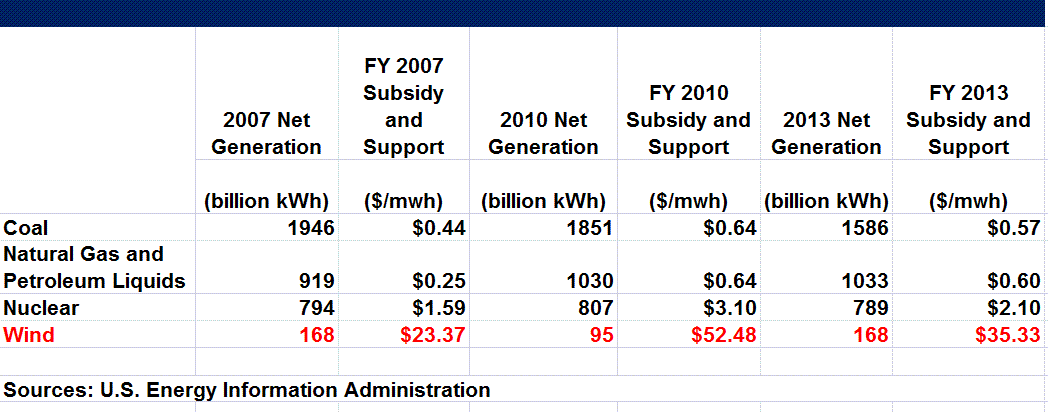DOE Wind Fantasies (same assumptions, same results)
By Lisa Linowes -- March 24, 2015“Before Americans are asked to pay more billions for an energy resource that still, after 23 years, cannot stand on its own two feet, Congress should ask DOE to get out of the vision business and report on the practicality of wind energy reaching even 10% of the U.S. power market.”
The Department of Energy, has once again buddied up with its friends in the wind industry to release an updated vision of how the United wind energy can achieve a 20% market share of the electricity (not total energy) market by 2030. This time, DOE went a step further to claim we could get to 10% wind by 2020 and a whopping 35% wind by 2050 (wind’s current electric-market share is 4.5%).
A quick review of the report suggests it suffers the same flaws as DOE’s last attempt from 2008. For example, using DOE’s own numbers, between now and 2020 (5 years), the U.S. would need to:
1) Install another 52,000 MW of wind. That would be more than 10,000 MW per year;
2) Of this, 3,000 MW would be offshore, where none exists today. (DOE’s analysis was completed before Cape Wind collapsed);
3) Improve overall capacity factors to 40% average where they have stagnated at 30% for years.
Obviously, we will not see a change in capacity factors for existing wind projects, so that means the next 52,000 MW will have to operate at efficiencies of roughly 50%. DOE’s report, apparently banks on technology improvements between now and 2020 to achieve the increases in production. It also banks on the continuation of the wind production tax credit (PTC).
But what DOE seems to be downplaying is the fact that the wind PTC has never led to the type of wind development the agency is claiming possible.
The years when we had large deployments of wind turbines were tied to the 1603 cash grant program in place from 2009-2012. And these were discrete events – 2010 had 10,000 MW and 2012 had 13,000 MW – with an average across the four years of roughly 8,000 MW. In 2013, only 1,000 MW were installed after the cash grant program expired and the industry flushed it’s project pipeline racing to get the grant money.
Whether DOE’s vision has credibility is one question before us. The second is whether American taxpayers want, or can afford the “investment” in wind power. The federal budget deficit promises to be a major issue for reform in the 2016 elections, if not before.
According to EIA, wind energy received the largest share of direct federal subsidies and support in FY 2013, accounting for 37% of total electricity-related subsidies ($5,936 billion). Nearly three-fourths of FY 2013 wind energy subsidies were direct expenditures largely resulting from the grant program. FY 2013 did not represent the biggest payout for wind. Costs associated with the federal grant program are assigned to the year in which a project is placed in service. In FY 2010, 84% of Section 1603 grant payments went to wind energy.
Looking at the cost per megawatt hour paid to fund wind versus other beneficiaries, the numbers are staggering. The below table relies on data from EIA for the years 2007, 2010, and 2013.
These numbers represent only the federal subsidies paid to wind versus other technologies. Additional subsidies are available to wind through state renewable portfolio standards and integration costs borne by rate- and taxpayers.
Before Americans are asked to pay more billions for an energy resource that still, after 23 years, cannot stand on its own two feet, Congress should ask DOE to get out of the vision business and report on the practicality of wind energy reaching even 10% of the U.S. power market.

Reposted at Deviantart.com http://kajm.deviantart.com/art/Here-s-your-free-wind-energy-522341603 – where the pro-wind argument is currently to call me a ‘liar’ and scream about ‘coal’ and ‘nocebo.’
Turns out that the major “subsidy” for nuclear is that they don’t have to pay taxes on a fund tat no OTHER energy source needs to maintain. They used to tax the growth in the decommissioning funds but now they leave them there for the fund to grow. Wow, NOT have a unique tax is now considered a subsidy. SMH
[…] http://www.masterresource.org/department-of-energymoniz/doe-wind-fantasies/ […]
How do we get the eco lobby to realize that nuclear is, by far, the ‘greenest’ technology available? Far smaller footprint, way less raptor/bat mortality, zero human deaths, fewer carbon emissions over a lifetime than wind turbines, cheaper, etc., etc.